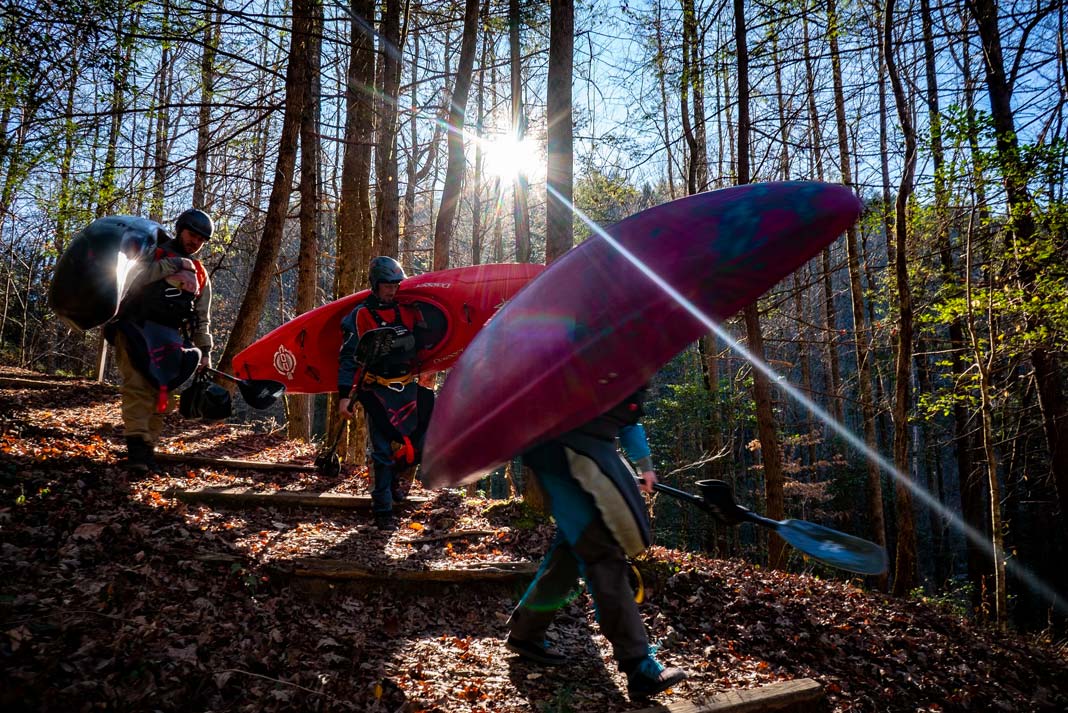Kayaks weren’t intended for rivers. They began as a mode of travel and hunting for the Inuit on the tidal waters of the North. Then as they gained wider use, some foolhardy souls decided these long, enclosed boats, with profiles as straight as an arrow and made of destructible material, would make fine vessels to travel wild rocky rivers in search of recreation and exploration. We are forever grateful for their misjudgment.
We’ve come a long way in kayak design, and because of it, whitewater has never been more exciting or as accessible to learn as it is today. This also means we’ve never had more options to choose from. There are fine models available from a collection of brands in North America. The hope for these top picks, however, is to not only share what I believe are the best whitewater kayaks out there but also provide you with some key elements worth considering when making your choice.
Best whitewater kayaks for 2025
Our top picks
Best whitewater kayak for beginners & all-around use
Jackson Kayak Flow
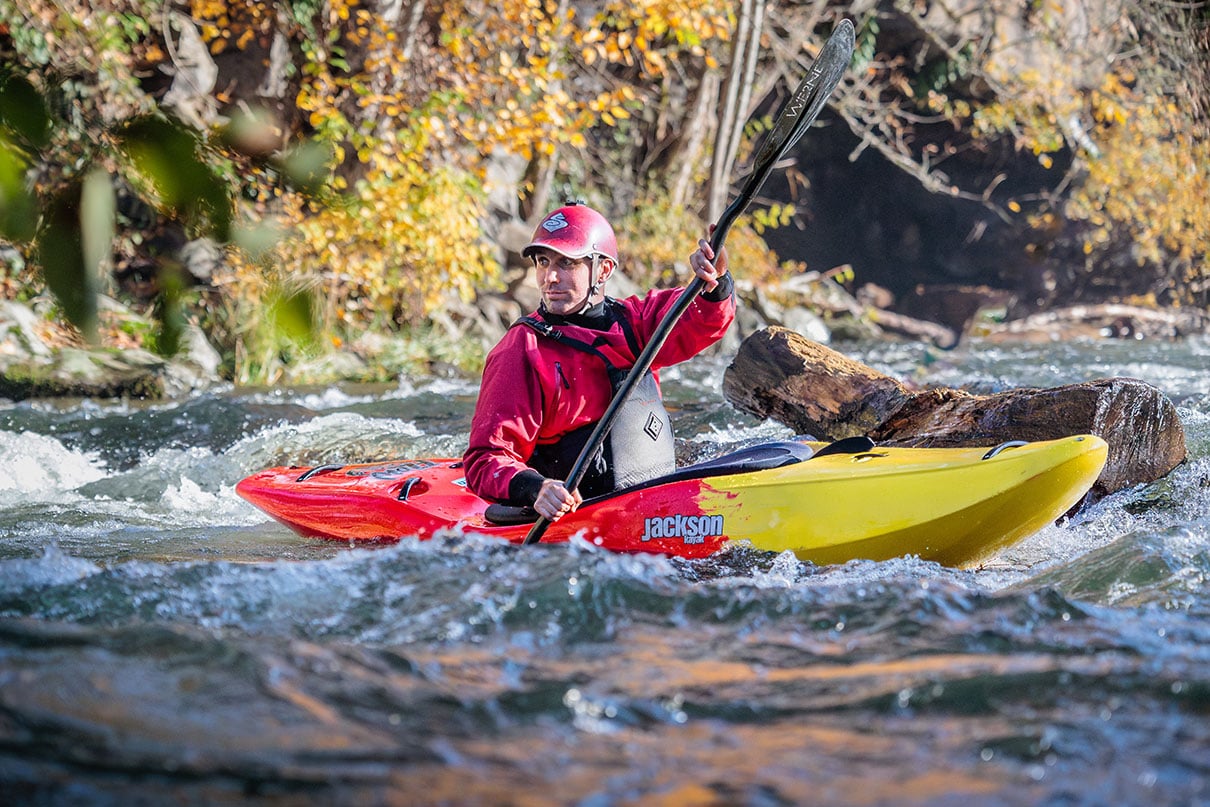
Jackson Flow Specs
Size: S | M | L
Length: 8’1” | 8’5” | 8’9”
Width: 26” | 26.75” | 28”
Volume: 67 | 77 | 86 gal
Weight: 44 | 46.76 | 48 lbs
Capacity: 100–170 | 130–190 | 180–260 lbs
MSRP: $1,599 USD
jacksonkayak.com
Buy from:
Why I love it
For someone starting out in this sport, the most important aspect of a whitewater kayak design is that it inspires confidence. This is exactly why I became enamored with the Jackson Flow the moment I sat in it.
The Flow is slightly shorter with less volume than most current river runner/creek boat designs. This gives the kayak a more manageable feel for beginning paddlers to learn how rivers work and evolve their abilities without sacrificing stability and forgiveness. The boat’s rocker and overall profile provide enough speed and the ability to carry you over and away from drops and holes. The combination of the hull design and edges means you can use features to move around on the river, carve up a wave or spin like a top. In fact, the Flow may be the easiest-to-surf kayak of its genre I’ve ever sat in.
The combination of design attributes within the Jackson Flow equates to a kayak that made me feel like I could do what I wanted, when I wanted, on the river. That feeling is of immense value for beginners, and why, once you’ve mastered the fundamentals, you still will not have outgrown the capability of this whitewater kayak.
Reasons to buy
- Enough size to inspire confidence without going overkill.
- A loose hull, combined with carvy edges and a tapered stern profile that surfs and utilizes features well.
- Easy to adjust outfitting that allows you to make adjustments on the go.
Consider another if
- You are looking for a half slice kayak that can perform moves like stern squirts (tailies).
- Steep, difficult, high-volume whitewater is your average day.
- You are not a fan of the Jackson outfitting system.
Bottom line
Beginner or not, if you are seeking an all-around river runner you can’t go wrong choosing the Jackson Flow as your whitewater kayak.
Best half slice to shred the river
Dagger Kayaks Rewind

Dagger Rewind Specs
Size: XS | S | M | L
Length: 6’9” | 8’4” | 8’9” | 9’4”
Width: 22.5” | 24” | 25.5” | 27”
Volume: 39 | 55 | 67 | 76 gal
Weight: 24 | 40 | 44 | 49.5 lbs
Capacity: 65–120 | 100–160 | 140–220 | 180–260 lbs
MSRP: $849 | $1,649 | $1,649 | $1,649 USD
dagger.confluenceoutdoor.com
Buy from:
Why I love it
In 1996, Dagger Kayaks released what is considered by many the most popular whitewater design of all time, the RPM. Over 20 years later, it’s no surprise that with the modern half-slice movement, Dagger has produced another masterpiece in the Rewind.
The intention of a half slice is to open every dimension of a river. The Rewind is not radical in any of these dimensions, but rather a sound and predictable design that allows it to be both playful when you want it to be and capable when you need it to be. Every year a brand releases a new half slice and still the Rewind maintains a place at the top as the best all-around choice.
There is perhaps no aspect of a half slice more sought after than the ability to sink the tail. The Rewind provides this through a gradual thinning of the stern from the cockpit to the end of the boat, finishing in the last few inches with a flat, squared-off stern that will allow you to pivot into some beautiful tailies (or stern squirts as previous generations of paddlers have called them). Sinking the stern vertical on the Rewind is not a gimme though, as it might be with other stern designs. I look at this as a good thing though for the kayak’s ability to run a difficult rapid with more predictability. It has volume in the bow and a progressive rocker to carry it over drops. The tucked-in edges slide over rocks and provide some forgiveness in turbulent current. It remains river-running minded and the closest thing out there to—excuse the cliche—a quiver killer of a kayak.
Reasons to buy
- Join the half-slice revolution and sink the stern.
- One of the most predictable boats available in this genre.
- Remains river-running-minded.
Consider another if
- Getting vertical on the stern outweighs forgiveness and predictability.
- You are looking for a pivot speed machine in hopes of Olympic kayak cross glory.
- A low-volume tail that will get stood up in strong currents is beyond your comfort zone.
Bottom line
There is a reason the Dagger Rewind remains a popular model five years after it first hit shop floors thanks to a beautiful balance of party and business.
Best for running the big stuff
Pyranha Scorch
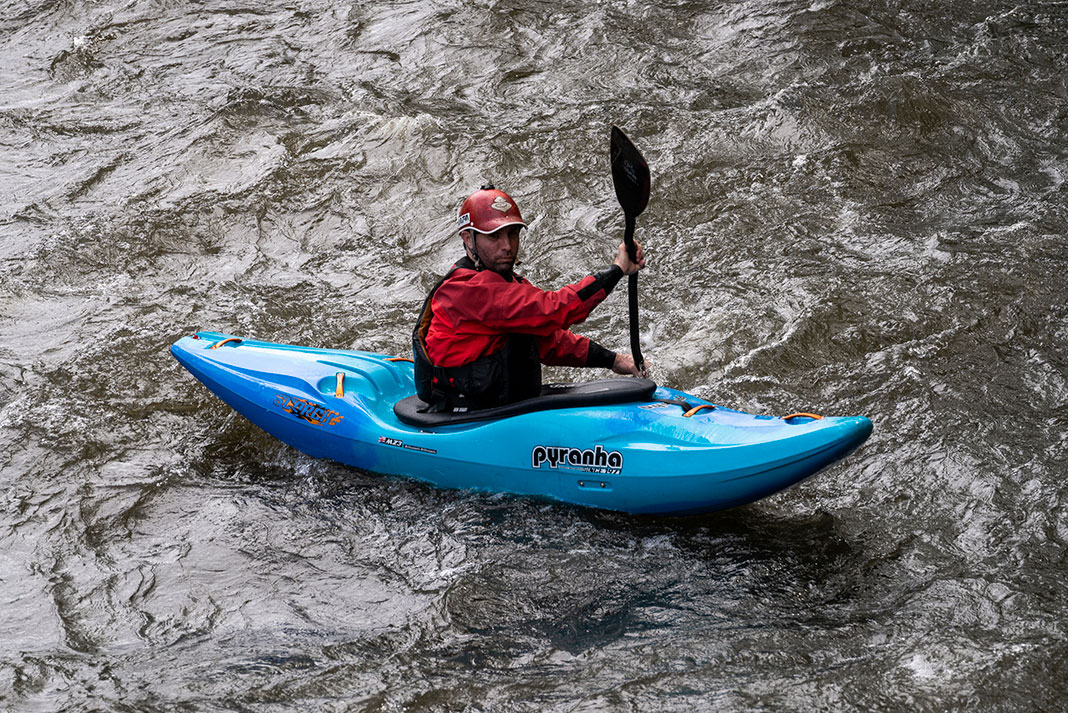
Pyranha Scorch Specs
Size: S | M | L
Length: 8’6” | 8’10” | 9’1”
Width: 24.5” | 25” | 25.5”
Volume: 70 | 82 | 90 gal
Weight: 46 | 50 | 54 lbs
Capacity: 88–165 | 145–200 | 175–255 lbs
MSRP: $1,799 USD
pyranha.com
Buy from:
Why I love it
No boat more embodies the spirit of what river runners of today want on steep, high-volume rivers than the Pyranha Scorch. Plane out, skip, lean, simply put, the Scorch is a styley rapid slayer.
The Scorch was well thought out in its bow-to-stern design, combining big bow rocker, a planing hull with sharp edges running through the stern, and a tapered stern in the back that allows you to pick up the bow with big, leaning boofs. Those elements also provide the ingredients for skipping over drops and planing out of runouts on the stern with control to maintain momentum for a flowy ride down burly reaches.
When I reviewed the Scorch, what stood out most as I entered rapids I had just scouted carefully, was the kayak design’s ability to have me saying, “That was it?” at the bottom. The Scorch has even gained an unofficial superlative claim as the most stable whitewater kayak out there. An attribute sought after both for running the biggest rapids in the world or learning the ropes.
Reasons to buy
- A boat profile made to style the biggest whitewater your adrenal glands can handle.
- Combo of bow rocker, tapered stern, hull and edges to master modern river running with leaning boofs and skips.
- A stable platform to stay upright.
Consider another if
- Big rocker and volume make you feel like you are up to your nose in a boat.
- You’re looking for softer edges or a displacement hull.
- You want to play the river.
Bottom line
If you daydream of skipping out of one waterfall and into the next in the steepest gorges on earth, the Pyranha Scorch is your steed.
Best for freestyle
Jackson Rockstar V
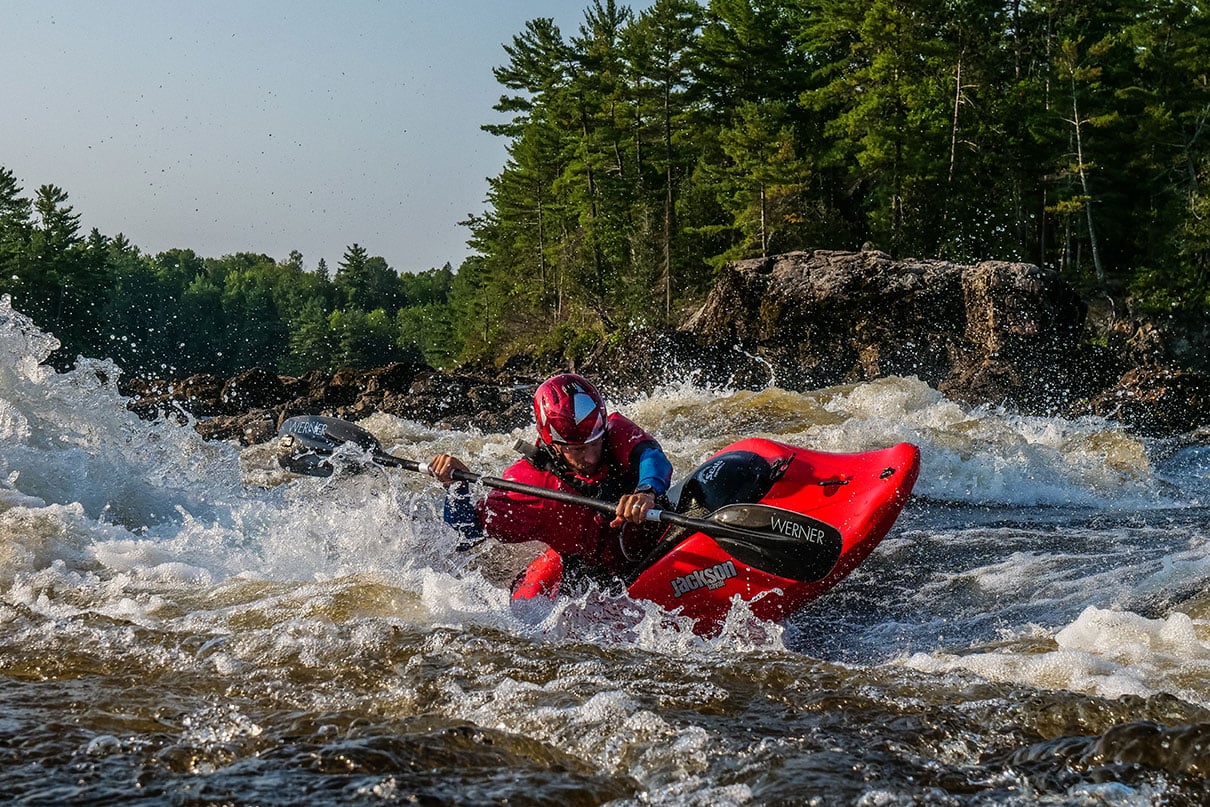
Jackson Rockstar V Specs
Size: S | M | L
Length: 5’4” | 5’8” | 5’11”
Width: 24.75” | 26.13” | 27.5”
Volume: 50 | 59 | 69 gal
Weight: 29 | 31 | 34 lbs
Capacity: 100–160 | 140–200 | 180–240 lbs
MSRP: $1,599 USD
jacksonkayak.com
Buy from:
Why I love it
I’ve paddled generations of Jackson freestyle kayaks, including the Rockstar series. Whenever I jump in one it has a way of making me feel like I can suddenly hit an easy button on aerial maneuvers I’ve spent years toiling away at.
A big reason why Jackson’s Rockstars make for more effortless freestyle is their constant focus, or at least my perception of it, on the ability to initiate tricks. The Jackson Rockstar V continues the trend. For the Rockstar V Jackson went back to a slicey bow that cartwheels and plugs into moves in a fashion reminiscent of their 2016 model. It has a narrowed stern that lets you release from features.
The Rockstar V also has perhaps the loosest hull Jackson has ever designed to slide around and spin on waves and holes. The looseness of a hull is a key element both for setting up on a feature, whether for a flat spin or rotating into a McNasty, and for recovering after tricks to restabilize your surf on the the wave or hole. With the Rockstar V, Jackson has accomplished this with a double rail stepping down from the sidewall to the hull—something they’ve never included on a freestyle kayak before.
Reasons to buy
- Easy to initiate the bow.
- Loose Hull spins like a top.
- Bees Knees Thigh Hooks are quick and easy to adjust, and Jackson has included a foam foot-block standard.
Consider another if
- You are not a fan of Jackson’s rope and cleat backband or other outfitting components.
- Your local rivers don’t hold quality playspots and a half slice would better serve your appetite for verticality.
Bottom line
The Rockstar provides the tools to up your game, whether freeriding or trying to win a pro rodeo.
Best inflatable whitewater kayak
AIRE Tributary Tater
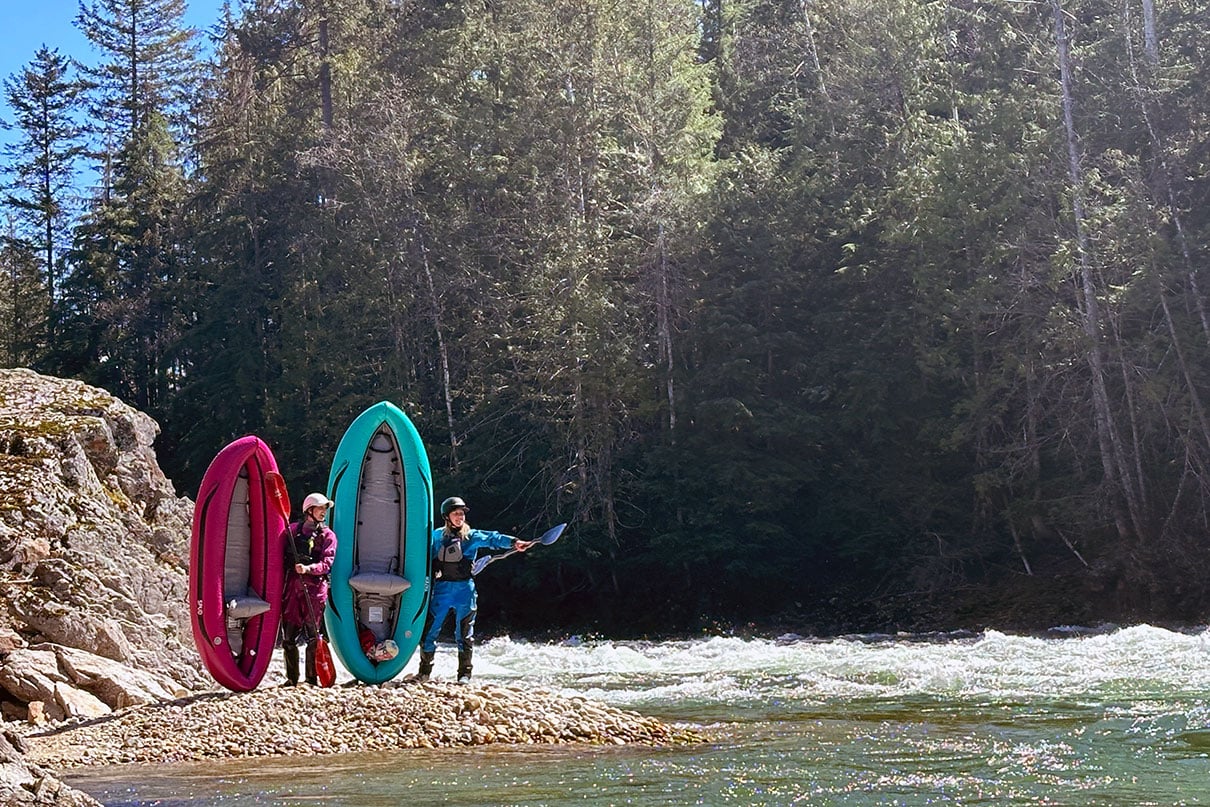
AIRE Spud & Tater Specs
Size: Spud | Tater
Length: 7’2” | 8’4”
Width: 35.5” | 38”
Tube Diameter: 11.5” | 11.5”
Weight: 21.5 | 24.5 lbs
Capacity: 220 | 275 lbs
MSRP: $539 | $699 USD
aire.com
Buy from:
AMAZON BACKCOUNTRY OUTDOORPLAY
Why I love it
Every time I’m talking with someone about the AIRE Tater we come to the same conclusion: the thing is a blast. Traditional inflatable kayak designs are known for having more stability than any other individual whitewater kayak, but they are also known for steamrolling rapids like a barge. The Tater, and its youth-sized accomplice, the Spud, remain stable yet sporty. Their smaller size feels playful in whitewater by allowing some of the exciting elements of running a river (see plugging holes and getting thrown around by waves) to take place without the learning curve of an enclosed whitewater kayak.
Being an open deck inflatable it also means you can climb back in when you flip. Speaking of open-deck kayaks, there is an odd inverse between whitewater and flatwater when it comes to inflatable kayaks versus sit-on-top kayaks. I’d recommend a plastic sit-on-top most of the time on other waterways, but on whitewater runs, they run up against their limitations quick. An inflatable like the Tater is going to be more versatile and fun in the long run.
The Tater and Spud feel inspired by the growth of packrafts and their compact designs. While it is by no means as light or rolls up as small as a packraft, it is built with a base material of PVC closer to the denier of a raft, providing a burly construction that stands up to abuse. Its low retail cost also makes it a great budget-friendly choice.
Reasons to buy
- Inflatable kayak in a smaller package that is the perfect blend of stability and excitement.
- An open cockpit means you can climb back on after you flip.
- Burly PVC construction holds up to heavy use.
Consider another if
- You are planning to carry extensive gear, such as on a multi-day trip.
- You are seeking the traditional “barge” feel of an inflatable kayak.
- You want technical performance only available with a sit-inside hardshell whitewater kayak.
Bottom line
I’ll say it again, whether you are a whitewater veteran, beginner or looking for a boat for your kid, the Tater and smaller Spud are a blast.
Best for letting kids test the wild waters
Liquidlogic Remix 47

Liquidlogic Remix 47 Specs
Length: 7’3”
Width: 21”
Volume: 47 gal
Weight: 28 lbs
Capacity: 45–110 lbs
MSRP: $899 USD
liquidlogickayaks.com
Why I love it
If a brand is still selling a whitewater kayak over 15 years later, it’s a design you can trust your kids with. The Remix has been beloved for years for its speed and rounded, forgiving hull. Personally, I paddled both the Remix 69 and 79 for years as my creek boats. The Remix series is also loved by kayak schools, and the smallest size, the Remix 47, is a great choice for your kid’s first whitewater kayak.
For years, river running designs were getting shorter—the Remix changed the narrative. Instructors knew this boat would be a benefit to building fundamentals in the sport. Back in 2008, when the Remix was first released, Paddling Magazine founder Scott MacGregor reviewed the boat and asked instructors what they found so exciting about it.
“This group of top instructors,” MacGregor wrote, “strongly believe kayaks need a minimum amount of speed, stability and tracking for beginners to understand the basic concepts of paddling whitewater.”
The Remix succeeded and is still building the foundation of our sport today with its youth size.
Reasons to buy
- Trusted design around for nearly two decades.
- Length-to-width ratio provides speed needed to properly learn fundamentals like eddy turns and peel-outs.
- Rounded hull is forgiving while learning to understand the dynamics of currents.
Consider another if
- The Remix 47 doesn’t fit your child properly
- You are looking for a flat planing hull
- They would feel more comfortable with an open-deck boat like an inflatable whitewater kayak.
Bottom line
The Remix series has been a successful design in production for nearly two decades—the record speaks for itself.
What to consider when buying a whitewater kayak
There are plenty of niches within whitewater, but if you can only own one kayak, buy the boat that you are going to enjoy paddling on the majority of the stretches you run. You also want your kayak to be a design that simultaneously allows you to progress your skill level, but doesn’t lead to consistent frustration.
If your river is class II–III but lacks features capable of freestyle rides, look toward a half slice that makes your whole run playful and allows you to challenge yourself. If you are new to the sport and staying upright and feeling stable are your priorities while you get the basics down, consider a full-volume river runner/creek boat. And if you just want to float down stretches of mild to moderate whitewater without being in an enclosed boat, or learning skills like rolling, an inflatable is going to be an incredible way to experience rivers.
As you spend time whitewater kayaking you are going to gain a better appreciation of where you want to go with the sport and what types of waterways you want to run, and your sense of the type of boat you want to paddle may evolve as well.
Best whitewater kayak brands
- Dagger Kayaks
- Pyranha Kayaks
- Jackson Kayak
- Liquidlogic Kayaks
- Waka Kayaks
- Zet Kayaks
- Prijon Kayaks
- Lettman Kayaks
How we tested
The kayaks in this article were chosen through recent years of accumulated experience with numerous whitewater models, as well as the input of our contributors through our extensive boat reviews.

Why trust us
Our digital editor Joe Potoczak has paddled whitewater for more than 20 years. He has run rivers on four continents, led instruction programs, competed in freestyle competitions and whitewater races, and is a former member of the U.S. Wildwater team.
Feature photo: Scott MacGregor




